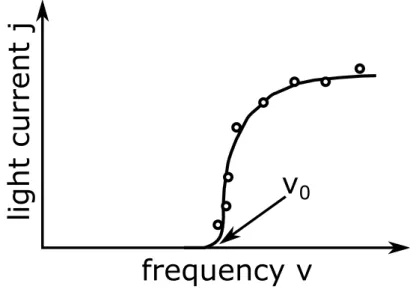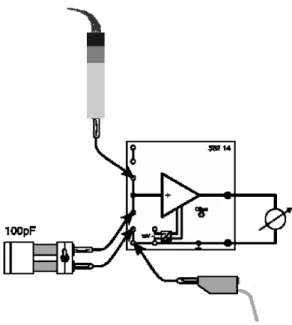IIA3
Modul Atomic/Nuclear Physics
Photo effect
Using different experiments, it was at the end of the last century shown
that electrons can be freed from a metal by irradiating the surface with
light. This process is called photoelectric effect (photo-emission) and the
emitted electrons are photo-electrons. By means of the photon emission,
it is possible that P
LANCK’
Sconstant can be determined.
Using different experiments, it was at the end of the last century shown that electrons can be freed from a metal by irradiating the surface with light. This process is calledphotoelectric effect (photo-emission)and the emitted electrons arephoto-electrons. By means of the photon emission, it is possible that PLANCK’Sconstant can be determined.
c
AP, Department of Physics, University of Basel, September 2016
1.1 Preliminary Questions
• Describe the photoelectric effect in their own words.
• Describe exactly how the energy of the photons is measured in the photocell.
• Why did the high-pressure mercury lamp have a (discrete) line spectrum?
1.2 Theory
1.2.1 Photo electrons
Looking for a source of electromagnetic waves was examined H
EINRICHH
ERTZin 1887, with the discharge between two electrodes. He observed that the intensity of the discharge grew when the cathode was irradiated with ultraviolet light. The effect suggested the as- sumption that metal surfaces are irradiated with light, emit electrons. Shortly afterwards, W. H
ALLWACHSand somewhat later P. L
ENARDcould find evidence of electron emission of irradiated surfaces with zinc, potassium, rubidium and sodium.
In a metal, there are many electrons, that more or less move together freely through the crystal lattice. If not for high temperatures, but can not galvanize from the metal because they have too little energy due to the strong C
OULOMBforce to overcome forces at the surface. One possibility to give the electron more energy is to heat the metal. "Steaming" the electrons then from the top face out; they are then called thermal electrons. This type of electron emission (thermal emission) occurs in electron tubes. A second possibility is the field emission. Here, a strong external electric field electron challenges from the metal sucked. The emerging field electrons can be noticed by electric sparks in the air, as in spark plugs.
1.2.2 M
ILLIKAN’s Observations
In 1914, A. M
ILLIKANexamined the photoelectric effect again with the great care. Figure 1.1 shows a schematic representation of the experimental arrangement: to great confusion of his contemporaries, his observations were not explained with the classical rectangular wave theory of light (electrodynamics):
incoming photons
electrons
photo-cathode collector / anode
V+
light current
Figure 1.1: Schematic representation of M
ILLIKAN’
SSetup
3
• Emission of electrons (i.e., the photoelectric current in the electrode j) grows, although, with the intensity of the incident on the metal surface light radiation; the kinetic en- ergy of the emitted electrons proves irrespective. After electrodynamics, the intensity I increases with the amplitude ~ E of the light wave on the electron. Therefore, it is ex- pected, that with the electric power e ~ E, that the kinetic energy E
kinof the photo-electron increases with I, which is not confirmed from experiments.
• In contrast, a characteristic dependence of electron emission from the frequency of the incident radiation is detected. Figure 1.2 shows this dependence. Apparently there is a minimum light frequency ν
0(still dependent on the material) so that no matter how intense the radiation is, does not generate photo-electrons when the light frequency is lower than ν
0. Also, this phenomenon is in contradiction to the classical wave theory of light. This namely means that the photoelectric effect occurs at each frequency, assum- ing that the intensity of the irradiated light strong is enough to beat electrons from the surface.
• In addition, the wave theory predicts that in low light radiation, a noticeable time elapse should be switching between the light and the engine where the electron has absorbed enough energy so that it can leave the metal. Experimentally, no such delay was noted.
li ght curr ent j
frequency ν ν 0
Figure 1.2: Dependence of the electron emission from the frequency of the incident light
1.2.3 E
INSTEIN’
SDeclaration
In 1905, a decade before M
ILLIKAN’
Sexperiment, Albert Einstein proposed, having regard to the sightings of L
ENARD, a simple but revolutionary theory of the photoelectric rule effect as:
Φ is the energy that an electron needs to escape from a given metal. This electron absorbs light radiation energy E and it gains kinetic energy:
E
kin= E − Φ (1.1)
Obviously, emission occurs only when it is greater than Φ . E
INSTEINpostulated analogously as put forward by M
AXP
LANCK, a quantum hypothesis in another context that the energy of
4
the light radiation from the electron is only in quanta of size:
E = h ν (1.2)
and can be absorbed. Here, ν is the frequency of light and h is P
LANCK’
Sconstant. For the kinetic energy of the photo-electrons, it is obtained:
E
kin= h ν − Φ . (1.3)
Not all electrons need as much energy Φ to get out of the metal. However, for each metal, there is a minimum energy Φ
0, which is called the work function. Therefore, the maximum kinetic energy of a photo-electron is:
E
kinmax= h ν − Φ
0. (1.4)
It follows that for frequency ν
0=
Φ0/
h, the maximum kinetic energy E
kinmax= 0 becomes; i.e. ν
0is that minimum frequency of occurrence of the photoelectric effect. For frequencies ν smaller than ν
0, it is h ν smaller than the minimum required work function Φ
0and therefore, is no photo-emission on it.
5
1.3 Experiment
1.3.1 Equipment
Components Number
Optical system with a photocell 1
Electrometer amplifier 1
Measuring capacitor with a button 1
Multimeter 1
Coaxial measuring cable 1
Experimental leads 5
Power supply for high-pressure mercury lamp 1 1.3.2 Experimental Setup
a
bc e f
g hi
j
k
l d


